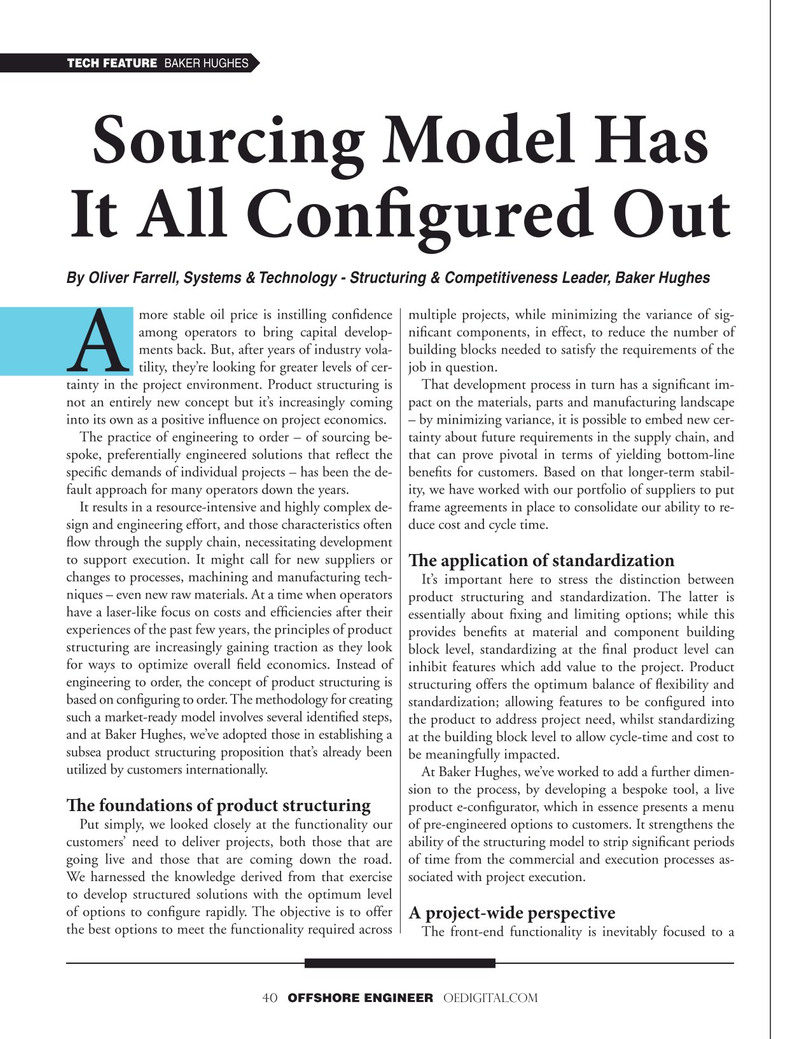
Page 40: of Offshore Engineer Magazine (Mar/Apr 2022)
Read this page in Pdf, Flash or Html5 edition of Mar/Apr 2022 Offshore Engineer Magazine
TECH FEATURE BAKER HUGHES
Sourcing Model Has
It All Conf gured Out
By Oliver Farrell, Systems & Technology - Structuring & Competitiveness Leader, Baker Hughes more stable oil price is instilling con? dence multiple projects, while minimizing the variance of sig- among operators to bring capital develop- ni? cant components, in effect, to reduce the number of ments back. But, after years of industry vola- building blocks needed to satisfy the requirements of the tility, they’re looking for greater levels of cer- job in question.
A tainty in the project environment. Product structuring is That development process in turn has a signi? cant im- not an entirely new concept but it’s increasingly coming pact on the materials, parts and manufacturing landscape into its own as a positive in? uence on project economics. – by minimizing variance, it is possible to embed new cer-
The practice of engineering to order – of sourcing be- tainty about future requirements in the supply chain, and spoke, preferentially engineered solutions that re? ect the that can prove pivotal in terms of yielding bottom-line speci? c demands of individual projects – has been the de- bene? ts for customers. Based on that longer-term stabil- fault approach for many operators down the years. ity, we have worked with our portfolio of suppliers to put
It results in a resource-intensive and highly complex de- frame agreements in place to consolidate our ability to re- sign and engineering effort, and those characteristics often duce cost and cycle time. ? ow through the supply chain, necessitating development to support execution. It might call for new suppliers or
T e application of standardization changes to processes, machining and manufacturing tech-
It’s important here to stress the distinction between niques – even new raw materials. At a time when operators product structuring and standardization. The latter is have a laser-like focus on costs and ef? ciencies after their essentially about ? xing and limiting options; while this experiences of the past few years, the principles of product provides bene? ts at material and component building structuring are increasingly gaining traction as they look block level, standardizing at the ? nal product level can for ways to optimize overall ? eld economics. Instead of inhibit features which add value to the project. Product engineering to order, the concept of product structuring is structuring offers the optimum balance of ? exibility and based on con? guring to order. The methodology for creating standardization; allowing features to be con? gured into such a market-ready model involves several identi? ed steps, the product to address project need, whilst standardizing and at Baker Hughes, we’ve adopted those in establishing a at the building block level to allow cycle-time and cost to subsea product structuring proposition that’s already been be meaningfully impacted.
utilized by customers internationally.
At Baker Hughes, we’ve worked to add a further dimen- sion to the process, by developing a bespoke tool, a live product e-con? gurator, which in essence presents a menu
T e foundations of product structuring
Put simply, we looked closely at the functionality our of pre-engineered options to customers. It strengthens the customers’ need to deliver projects, both those that are ability of the structuring model to strip signi? cant periods going live and those that are coming down the road. of time from the commercial and execution processes as-
We harnessed the knowledge derived from that exercise sociated with project execution. to develop structured solutions with the optimum level of options to con? gure rapidly. The objective is to offer
A project-wide perspective the best options to meet the functionality required across
The front-end functionality is inevitably focused to a 40 OFFSHORE ENGINEER OEDIGITAL.COM

 39
39

 41
41